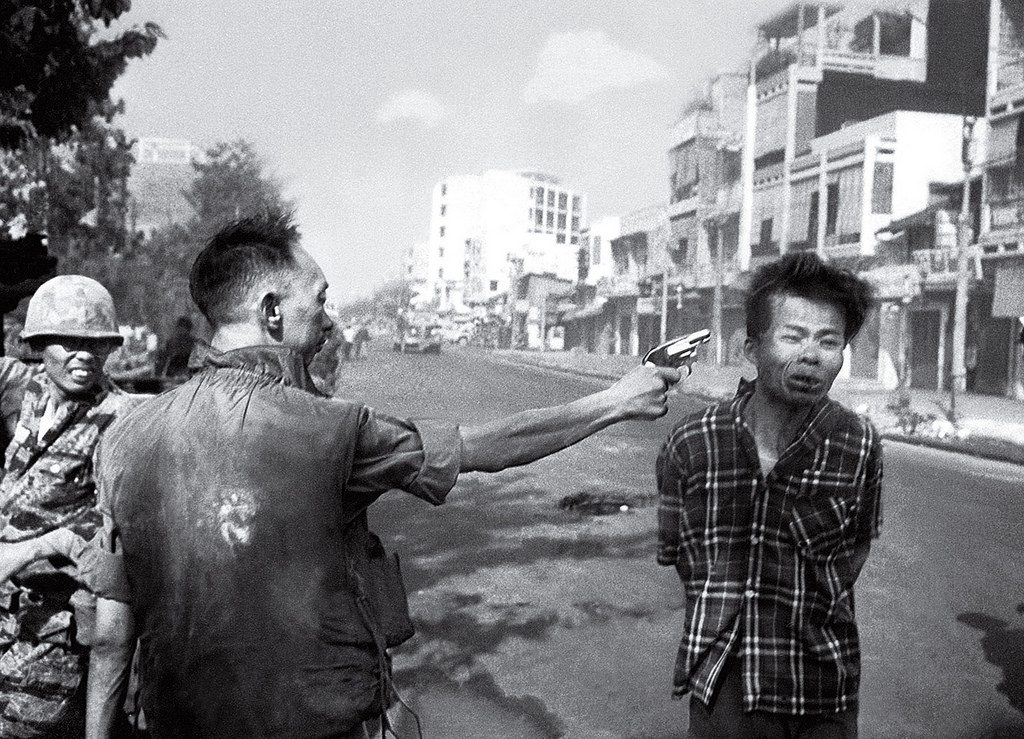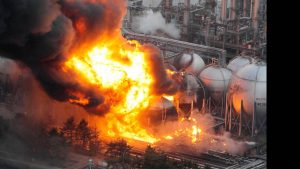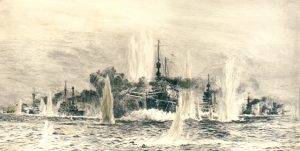Winner of the Fall 2018 StMU History Media Award for
Article with the Best Use of Images
Article with the Best Introduction
The year was 1968. The month of January was almost over and “Tet,” the Vietnamese Lunar New Year, was about to begin. By now, Vietnam had been embroiled for years in a civil war. North Vietnam was under the leadership of a Communist government and South Vietnam was under the leadership of a government that was backed by West. The start of Tet in 1968 was used to launch a huge offensive by the Vietcong in which coordinated attacks took place all over South Vietnam to destabilize the region and push the United States to withdraw.1
The United States‘ intervention in Vietnam began in 1965, a year after the unwarranted attacks by North Vietnam on United States‘ Destroyer ships in the Gulf of Tonkin. By 1967, the number of American troops on the ground surged.2 Despite being involved in this conflict halfway across the globe, the war did not seem so distant with the steady stream of footage and photographs from the front-lines directly to living rooms all over America. In this regard, Vietnam was unique for being one of the first wars to be filmed and photographed extensively.3 The work done by journalists in Vietnam allowed the world to see what was happening in Vietnam firsthand. Among those in Vietnam documenting the war was Eddie Adams.
Eddie Adams had been involved with photography since an early age. He had been a photographer for his high school newspaper and had done some photography work for weddings. Upon graduating high school, he enlisted in the United States Marine Corp. As a Marine, Adams served as a combat photographer in Korea for almost 3 years. In 1965, in what he describes as an “alcoholic haze,” Adams and a close friend decided they would go to Vietnam to document the war.4 During his time in Vietnam is when Adams took the photograph of the Saigon execution.
The day Adams shot the picture featured above was February 1st. He recalls himself and NBC journalists heading toward Cholon, a section of the city of Saigon, because they heard of a battle taking place there. Adams came upon South Vietnamese Brigadier General Nguyen Ngoc Loan executing a Vietcong soldier, in cold blood, in broad day light, in the middle of the street. Adams recalls himself and the other journalist gathering around Loan as he grabbed the soldier. Adams assumed Loan was only going to threaten the man. In the instant Adams raised his camera to snap a photo, Loan raised his pistol and executed the soldier. Loan explained after, that the Vietcong soldier had killed many Americans and allied Vietnamese soldiers.5
The photograph showed up on all major news evening broadcasts and on the front cover of newspapers all over the world the next morning.6 The execution was also recorded, but the specific angle Adams got in his photograph showed the war in an indescribable way. Peter Braestrup, one of the most versed individuals on the Tet offensive, described the picture as a “kind of ultimate horror story that you captured in living color. But in terms of information it told you almost nothing.”7 His quote could not do more justice. What the world saw was a man who was wincing before certain death. They did not know the man was a part of the Vietcong. In the photograph, he seems to be wearing civilian clothes which misleads one. The man had also recently killed allied soldiers and was found armed during martial law- an offense that justifies the use of force.8 Eddie Adams believed he had done an injustice to Loan. He explained, “General Loan was our guy. We were supporting him… believe me, the Americans did just as bad things. I just happened to see this and shoot it…”9

Despite the Johnson Administration’s attempt to win public support of the war, the images of the war painted a very different picture. Public opinion felt that the war was no longer winnable, rather it was now a matter of how America could save face. Walter Cronkite, a well-respected news-anchor and a strong supporter for the war, was among those whose opinion shifted. It was reported that President Johnson believed “if I lost Cronkite, I’ve lost America.”10 The irony of it all was that the Tet Offensive was largely a failure for the Vietcong in terms of land gained and damage inflicted, but in the end its psychological impact on how Americans believed the war to be going, led to its success.11

While this photo was taken out of context, it did provide small truths of the war. Although the war was going well, horrendous acts were being committed. Eddie Adams and many others were able to expose the world to the atrocious acts being committed during the war. Nick Ut’s photo of a napalm strike on a village, is another photo that came to define the war. Ut’s photograph captured the moment children run away in horror from napalm strikes on their village.12 The shattered innocence and utter despair on the childrens’ faces while soldiers seem calm provides a stark incomprehensible contrast that pulls at the heart. These photographs captured only instances of the war. But in the frozen state of a photograph, one is able to examine and reexamine a photograph and truly take in all its details. There was no propaganda campaign that could ever keep a just people supporting a war when they saw photographs like these.

As journalist, Adams and the others were simply doing their jobs. Horst Faas explained about documenting the war, “I don’t think we influenced the war… [he believed simply that the job of journalist was to] record the suffering, the emotions and the sacrifices of both the Americans and the Vietnamese…”13 Their work allowed for the false reality America was living to fall apart. As Americans lived, worked, and played, the very basic rights all humans are entitled to were violated by both sides. As such, Americans responded. In 1973, with public support overwhelmingly against the war in Vietnam, the United States signed the Paris Agreement that led to the withdrawal of all American troops.14 The involvement of the United States in Vietnam continues to be synonymous with some of the most appalling violations of human rights, not only violations against Vietnamese civilians burned alive with napalm or killed slowly through cancer with massive exposure to Agent Orange, but also of the atrocities committed or witnessed by US forces. In addition, all US Soldiers exposed to Agent Orange in indirect ways as when combat medics who worked at Clark Air Force Base (Philippines Islands) received the US soldiers injured in Vietnam who had been evacuated by air. These combat medics received soldiers injured in the field in Vietnam covered in Agent Orange with no protocol for decontamination for the injured nor for themselves as medical personnel. Fifty years on and they continue to die from cancers caused by exposure to Agent Orange. While the US left in 1973, the human suffering due to human rights violations done then, continues today. These images changed the public opinion and changed the course of history even when they may have not saved all those involved at the time, they avoided even greater damages and loss of life, for that we are grateful to these powerful images.
- Patrick Hagopian, America in the World, 1776 to the Present: A Supplement to the Dictionary of American History (Farmington Hills, MI: Charles Scribner’s Sons, 2016), 752. ↵
- James H. Willbanks, Vietnam War: A Topical Exploration and Primary Source Collection (Santa Barbara, CA: ABC-CLIO, 2017), 133, 183. ↵
- James H. Willbanks, The Tet Offensive: A Concise History (New York: Columbia University Press, 2007), 5-6. ↵
- Encyclopedia of World Biography, 2nd Edition, s.v. “Eddie Adams” (Detroit: Gale, 2005), 4. ↵
- Encyclopedia of World Biography, 2nd Edition, s.v. “Eddie Adams” (Detroit: Gale, 2005), 4. ↵
- David Culbert, Television’s Visual Impact on Decision-Making in the USA, 1968: The Tet Offensive and Chicago’s Democratic National Convention, Journal of Contemporary History Vol. 33 (1998): 421. ↵
- David Culbert, Television’s Visual Impact on Decision-Making in the USA, 1968: The Tet Offensive and Chicago’s Democratic National Convention, Journal of Contemporary History Vol. 33 (1998): 424. ↵
- David Culbert, Television’s Visual Impact on Decision-Making in the USA, 1968: The Tet Offensive and Chicago’s Democratic National Convention, Journal of Contemporary History Vol. 33 (1998): 423, 426-428 ↵
- Encyclopedia of World Biography, 2nd Edition, s.v. “Eddie Adams” (Detroit: Gale, 2005), 4-5. ↵
- James H. Willbanks, Vietnam War: A Topical Exploration and Primary Source Collection (Santa Barbara, CA: ABC-CLIO, 2017), 255. ↵
- James H. Willbanks, Vietnam War: A Topical Exploration and Primary Source Collection (Santa Barbara, CA: ABC-CLIO, 2017), 249 ↵
- Hal Buell, The Napalm Girl, Vietnam 25, no. 1 (June 2012), 36-39. ↵
- Deborah Stadler, Frontline Focus, Military History 33, no. 6 (March 2017), 56-61. ↵
- “12 Address to the Nation Announcing Conclusion of an Agreement on Ending the War and Restoring Peace in Vietnam. January 23, 1973.” 2001. American Reference Library – Primary Source Documents, (January, 1.) ↵



188 comments
Adam Portillo
Awesome article. I felt that this article did a really exceptional job with the images used. So many times we see images of war and all we can do is question the picture and wonder how it was during the moment in which it was taken in. The war in Vietnam was certainly a war that affected many of it’s own civilians. I couldn’t imagine living in a country where war is on it’s soil and they endured many terrible things.
Madeline Torres
It’s true when they say a picture is worth a million words. I cannot believe the amount of horror and fear these poor civilians went through. A picture can only show so much, but with the pictures provided we sure do have an idea on what occurred during the Vietnam war. No person should experience such pain and fear in their homeland and that’s exactly what these pictures show us. This article was very well written and informative, it kept me very intrigued and engaged.
Diego Aguilera
Its crazy that a picture can really say a thousand words and how it can change perspectives all around the world. Ive always seen this picture but never had any background information into it. Ive always known it was a controversy but to see that this image brought so much horror is wild. I really enjoyed this article and what it had to say. very descriptive and overall great article.
Gabriela Ochoa
The title really caught my attention and it turned out to be a really great article. I feel that having Eddie Adams there especially with his background in the military it gave him a better advantage to know what to capture to show the world how the war actually happening. I feel that his picture really showed the world what war was like.
Steven Hale
With Vietnam being the first war to have such extensive media coverage that the public could access, I wonder what the public opinion towards wars like World War II would have been like if there was video or photographs being constantly broadcast all over the country. I can see how these photographs jarred people into changing their opinions about the war. Just seeing them here makes me uncomfortable.
Micaela Cruz
This article I feel exemplifies the phrase, “a picture is worth a thousand words.” This article was interesting to read as the main idea was to provide deeper insight into how and what was really occurring during the Vietnam War. The author’s use of images throughout the telling of the story allowed the audience to not only read but to also see the tragic events that were occurring at the time.
Christopher Hohman
Nice article. Adam’s pictures sure were something. They really brought home to the American people how horrific things were happening to people on both sides of the conflict. The image of the man about to be executed was just so powerful. It did not matter that he was a member of the Vietcong or that he was also a murder, in that picture he was simply a man who was about to have his life taken. The image of the children running away from the Napal attacks is also really sad. It must have scarred them for life, and that is just devastating
Nathalie Herrera
I feel that images can impact millions in a manner of seconds and seeing the images from the war it is no wonder why so many people were in horror. Even now seeing those pictures it gives off a tragic feeling. Yet, the overall article had a great title that grabbed myself the reader immediately, and was very informative. Great read!
Angel Torres
The fact that the Vietnam War was one of the first wars to be filmed and photograph created a massive domestic impact in the United States. People were able to witness firsthand the atrocities that were occurring to not only the soldiers, but also the innocent people of Vietnam. The images used in the article evoke a sense of emotion in the reader. Great use of the images and well written article on how photography and videography impacted the Vietnam War.
Robert Freise
This article uses images to represent a very powerful meaning of how violent and nasty war can be. I like the way the article describes how each of the events of the war. The writer did a great job explaining the events to chronological order. This article really underlys the problems of war and it is really a great article. Love the word choice and I love the use of powerful imagery. Great Job!!